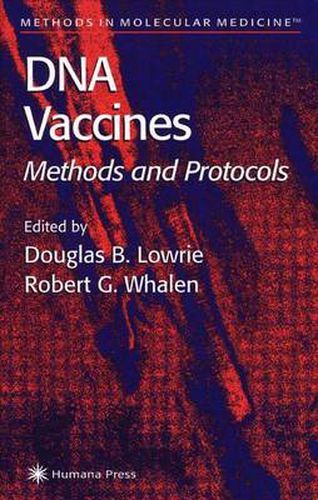Readings Newsletter
Become a Readings Member to make your shopping experience even easier.
Sign in or sign up for free!
You’re not far away from qualifying for FREE standard shipping within Australia
You’ve qualified for FREE standard shipping within Australia
The cart is loading…






This title is printed to order. This book may have been self-published. If so, we cannot guarantee the quality of the content. In the main most books will have gone through the editing process however some may not. We therefore suggest that you be aware of this before ordering this book. If in doubt check either the author or publisher’s details as we are unable to accept any returns unless they are faulty. Please contact us if you have any questions.
The field of DNA vaccines has undergone explosive growth in the last few years. As usual, some historical precursors of this approach can be d- cerned in the scientific literature of the last decades. However, the present state of affairs appears to date from observations made discreetly in 1988 by Wolff, Malone, Felgner, and colleagues, which were described in a 1989 patent and published in 1990. Quite surprisingly, they showed that genes carried by pure plasmid DNA and injected in a saline solution, hence the epithet naked DNA, could be taken up and expressed by skeletal muscle cells with a low but reproducible frequency. Such a simple methodology was sure to spawn many applications. In a separate and important line of experimentation, Tang, De Vit, and Johnston announced in 1992 that it was indeed possible to obtain humoral immune responses against proteins encoded by DNA delivered to the skin by a biolistic device, which has colloquially become known as the gene gun.
The year 1993 saw the publication of further improvements in the me- ods of naked DNA delivery and, above all, the first demonstrations by several groups of the induction of humoral and cytotoxic immune responses to viral antigens expressed from injected plasmid DNA. In some cases, protection against challenge with the pathogen was obtained. The latter result was - questionably the touchstone of a method of vaccination worthy of the name.
$9.00 standard shipping within Australia
FREE standard shipping within Australia for orders over $100.00
Express & International shipping calculated at checkout
This title is printed to order. This book may have been self-published. If so, we cannot guarantee the quality of the content. In the main most books will have gone through the editing process however some may not. We therefore suggest that you be aware of this before ordering this book. If in doubt check either the author or publisher’s details as we are unable to accept any returns unless they are faulty. Please contact us if you have any questions.
The field of DNA vaccines has undergone explosive growth in the last few years. As usual, some historical precursors of this approach can be d- cerned in the scientific literature of the last decades. However, the present state of affairs appears to date from observations made discreetly in 1988 by Wolff, Malone, Felgner, and colleagues, which were described in a 1989 patent and published in 1990. Quite surprisingly, they showed that genes carried by pure plasmid DNA and injected in a saline solution, hence the epithet naked DNA, could be taken up and expressed by skeletal muscle cells with a low but reproducible frequency. Such a simple methodology was sure to spawn many applications. In a separate and important line of experimentation, Tang, De Vit, and Johnston announced in 1992 that it was indeed possible to obtain humoral immune responses against proteins encoded by DNA delivered to the skin by a biolistic device, which has colloquially become known as the gene gun.
The year 1993 saw the publication of further improvements in the me- ods of naked DNA delivery and, above all, the first demonstrations by several groups of the induction of humoral and cytotoxic immune responses to viral antigens expressed from injected plasmid DNA. In some cases, protection against challenge with the pathogen was obtained. The latter result was - questionably the touchstone of a method of vaccination worthy of the name.